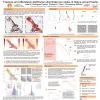Poster #131, Fault and Rupture Mechanics (FARM)
Composition and structure in the upper 2-4 km of major strike-slip faults
Poster Image:

Poster Presentation
2020 SCEC Annual Meeting, Poster #131, SCEC Contribution #10407 VIEW PDF
depth of 400 m, and the San Andreas Fault (SAF) was sampled by seven northeast plunging boreholes to a depth of 250 m with ~ 95% core recovery rate of relatively intact core. Due to post faulting uplift of the San Gabriel Mountains, fault-related rocks of the SGF could have formed as deep as ~ 4 km depth. Petrographic, mineralogic, whole-rock geochemical analyses, and X-Ray fluorescence mapping of core and thin sections reveals evidence for abundant and repeated syntectonic alteration, shearing and brecciation of fractured damage zone rocks, formation of foliated cataclasites, pseudotachylites, and clay and chlorite-rich shear zones. The SGF exhibits a classic fault-core damage zone structure, whereas the SAF comprises a wide zone of distributed deformation with several candidate zones that may represent the active slip surface. These transformations resulted in mineralogical transformation of gneiss protolith to low frictional strength clay- and chlorite-rich fault gouge and cataclasite. Textural evidence for repeated shearing, alteration, vein formation, brittle deformation fracture, faulting, and re-lithification of faulted rocks suggests a prolonged history of repeated alteration-deformation cycles . We suggest that a significant degree of hydrothermal alteration occurred during deformation at surprisingly shallow crustal levels in these faults. The altered and sheared rock assemblages likely represent significantly weakened rocks that have the potential to slip at low shear stresses, experience creep, and could accommodate aseismic slip over 101-104 years.
SHOW MORE
SHOW MORE























































